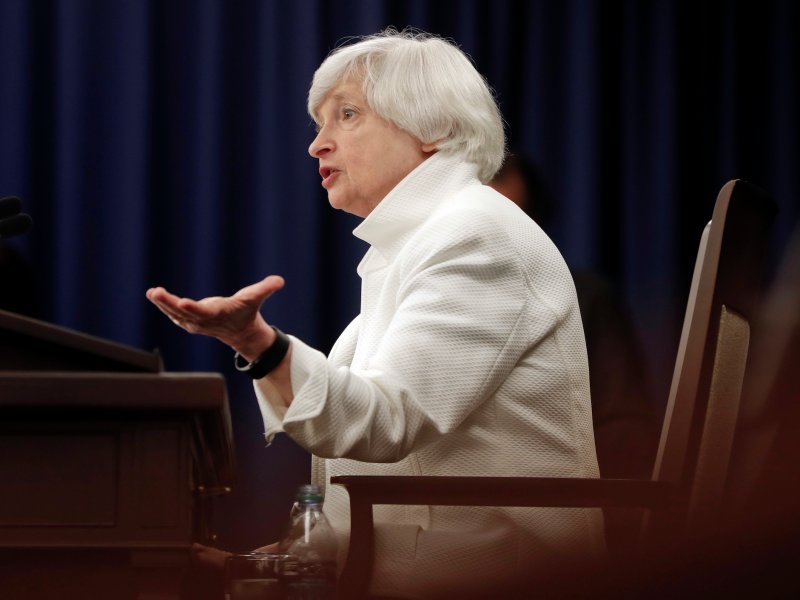- The Federal Reserve is widely expected to raise rates at its December policy meeting, making what it signals about future increases more of the focus.
- Fed officials are confident in the recovery, and are expected to stick to forecasts for another three or even four rate increases in 2018.
- Low inflation, which has undershot the Fed's 2% target for several years and points to lingering economic weakness, is a key factor that could complicate the outlook.
Federal Reserve policy has become sufficiently predictable that this week’s interest-rate hike matters a lot less than any hints the central bank may give about the pace of rate increases next year and beyond.
A December rise in the federal funds rate to a range of 1.25% to 1.50% has long been baked into Wall Street estimates. Economists will therefore be paying closer attention to the Federal Open Market Committee’s (FOMC) policy statement, its latest economic forecasts and Janet Yellen's last press conference as the central bank chair. The meeting will take place on December 12 and 13.
Yellen said in Congressional testimony on November 29 she and her colleagues "continue to expect that gradual increases in the federal funds rate will be appropriate to sustain a healthy labor market and stabilize inflation around the FOMC’s 2% objective" — even though inflation has remained consistently below that target for most of the economic recovery.
Fed Governor Jerome Powell is set to replace Yellen when her term ends in February, and several remaining open seats on the Fed’s board are making it more difficult than usual for Fed watchers to gauge the future of monetary policy. In this context, the Fed’s often dismissed "dot-plot" of officials’ own estimates for future rate hikes could gain added importance.
Powell told the Senate Banking Committee during his November 28 confirmation hearing he would aim "to support the economy's continued progress toward full recovery, … to sustain a strong jobs market with inflation moving gradually up toward our target."
He indicated interest rates would "rise somewhat further," but added officials should "retain the flexibility to adjust our policies in response to economic developments."
In their September estimates, Fed policymakers foresaw as many as three rate hikes in 2018 and a couple more in 2019. Lagging inflation has created some uncertainty around that path, and Fed Chair Janet Yellen herself recently acknowledged the worry that the low readings might not be "transitory," as many officials had expected.
Low inflation can reflect weak economic demand and point to a labor market still operating below its potential despite a historically low 4.1 % jobless rate.
Philadelphia Fed President Patrick Harker told Business Insider in a recent interview that he is "supportive of a December increase, but I think next year we’re going to have to wait and see."
"Inflation really hasn’t accelerated," Harker said. "We’ve seen some signs that it’s firming, but it’s not accelerating in a dramatic way so I think we have some time."
Despite a modest pickup in inflation, the latest reported annual gain in the Fed's preferred gauge was 1.6%, while consumer prices excluding food and energy rose just 1.4%. Weak wage growth is also restraining the outlook for consumer spending, which is a primary driver of US economic growth. Average hourly earnings rose just 2.5% on an annual basis in November.
"They seem pretty confident in the recovery and on a steady path of rate hikes, yet personnel [changes] make it harder to predict how they will react to the inevitably surprising developments next year," Julia Coronado, a former Fed economist, who is now president of MacroPolicy Perspectives, told Business Insider.
US economic growth has hovered around 2% for much of the recovery period following the Great Recession, which was the worst downturn in modern history, even if the past couple of quarters have shown robust quarterly annualized readings around 3%.
Austan Goolsbee, former chief economic adviser to President Barack Obama and a professor at the University of Chicago, tells Business Insider he doesn’t see things getting a lot better, "and that makes me think that the Fed won’t be able to hike rates as much as they think they will."
The Fed has raised interest rates four times since December 2015, having left the official federal funds rate at zero for seven years in response to the Great Recession and its aftermath.
Some at the Fed worry about whether they will have enough tools to address a potential future economic downturn.
"There are some risks that we run by keeping the federal funds rate too low for too long, because we don’t have any leg room to move in a shock, a moderate shock," Harker said. "Right now we will not have a lot in a major shock, and God willing we won’t have one in the foreseeable future."
Still, hurting the economy in order to save it seems like a curious approach.
"Let’s not forget, when the Fed raises rates, it’s trying to slow the economy, and it works," says Dan North, chief economist at Euler Hermes North America.
